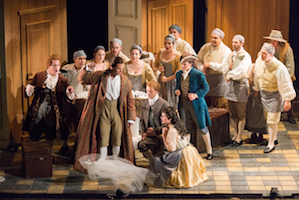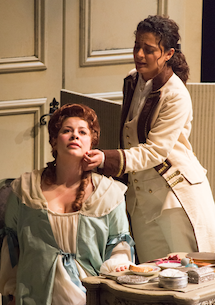
Photos by Kristen Loken
Imagine a 5K triathlon that takes you through the thorniest patches and most verdant of pastures, only to leave you exultant rather than exhausted at the end. That’s more than a bit how the Merola Opera program’s Nozze di Figaro felt at its first of two performances.
As zippily conducted by Xian Zhang, cleverly directed by Robin Guarino, and hilariously designed by wardrobe queen Donald Eastman — you’ll get it when you see it — this Marriage served as a stunning showcase for some unquestionable future stars of the operatic stage.
In dimensions, the somewhat intimate and rustic (as in high school primitive) confines of Everett Auditorium in San Francisco seem an ideal size for Mozart. But while the acoustic flatters voices, at least at the front of the auditorium, the absence of a sunken orchestra pit means that singers must compete with the instrumentalists seated on the floor between them and the audience.
At first, given the orchestra’s size and Zhang’s energetic conducting, this made for some competition as to supremacy. But somewhere in the midst of the first act, either my ear grew accustomed or everyone settled in, because what at first came off as a hasty dash that shortchanged joy and grace was transformed into a nonstop succession of melodic brilliance that seemed like a gift from the gods.
It was curious that, despite tempos that reflected period-practice scholarship, there was virtually no authentic embellishment or ornamentation on the part of the singers.
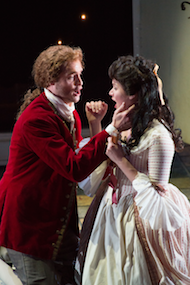
I noted just two: a modest, smile-inducing flourish at the end of one of Figaro’s arias, and (I think) a single extra note or two at the conclusion of Susanna’s final act aria, “Deh vieni non tardar” (Come now, my love, do not delay). Was this a conscious choice on the part of the conductor and Merola’s staff, or did it reflect a lack of rehearsal time or expertise?
Be that as it may, what we did hear was marvelous. Zhang’s conducting gained in flexibility as the opera progressed, with some sensitive freedom of tempo at the end of “Deh vieni non tardar” especially notable. As for the singers, at least five projected undeniable star potential, while the rest displayed gifts that, with time, could also propel them onto major stages.
At the top of the list was the superb baritone Joseph Lattanzi, whose immensely energetic, nigh-flawless Count Almaviva demonstrated how right Program director Sheri Greenawald and her Merola team were to grant him a second summer in the program. Moving foot and leg first, as in ballet, Lattanzi strutted, postured, and posed his way through the opera with a combination of voice and attitude that projected ruling-class attitude and even arrogance.
Although his instrument, at this point, is not as rich as leading-light Marius Kwiecen’s, his imposingly cocky stage manner and unflagging energy brought that illustrious baritone to mind. It’s hard not to believe that Lattanzi is on Greenawald’s short list for the next round of Adler Fellows.
At least five projected undeniable star potential, while the rest displayed gifts that, with time, could also propel them onto major stages.
At his side, I hope, will be the wonderful soprano Maria Valdes (Susanna). Equally lovely to gaze at, and just as strong in the acting department, she was able to control her every facial expression and movement, making them seem to arise naturally from her heart and gut rather than her head. The same can be said of her perfectly placed, sweet voice, which brought light to her every utterance. She also knows when to add body to the voice — perhaps a tad too much for “Deh vieni non tardar — and when to lighten. Both Valdes and Lattanzi dispensed their multifaceted gifts as would any artist of the first order.
Dr. Bartolo is not a huge role, but bass-baritone Thomas Richards possesses such beauty of voice that the audience rightfully applauded him as though he was singing one of the leads. Although he hammed it up a bit at opera’s end, as if he didn’t know what to do when his youthful hanky-panky came back to haunt him, he sure knew how to sing his way through the role. More, please.
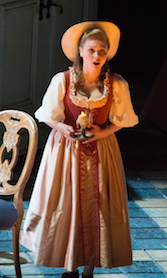
As his far more eager wife-by-default, Marcellina, mezzo-soprano Daryl Freedman has “future Catherine Cook” written all over her. Her personality is similarly outsized, and her voice also large, with a ripe tang and mature dowdiness that make her ideal for character parts. You couldn’t help but love her (not that you’d want to do anything different at this opera’s end).
Another total love was soprano Alisa Jordheim as Barbarina. Pure, light sopranos with sweet voices that project health and innocence are far too rare. Given the excellence of her Lucia in Merola’s previous production of The Rape of Lucretia, not to mention her physical beauty, the only question mark is her ability to project in a large house.
That, of course, will be determined when all of Merola’s artists perform in the War Memorial Opera House in their grand finale on Aug. 17. Although any number of artists with small or moderate-size voices — Fleming, Gheorghiu, Florez, Villazón, and Battle come to mind — have achieved international stardom, thanks in no small part to radio, television, and video, the ability to project from the big stage will prove decisive for at least some of these “Merolini.”
To mention a few more: As Figaro, bass-baritone John Arnold was “Count” Lattanzi’s ideal foil in energy and believability. (His rough, plebian countenance was an extra asset in this regard.) On the few occasions when he went inward to express pain or hurt, his voice also took on an ingratiating, warm mellowness that was otherwise absent from a portrayal that was stronger in force than in grace. Perhaps a role that allows him to express more vulnerability will show him to greater advantage.
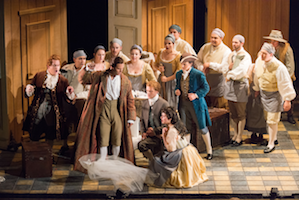
Mezzo-soprano Rihab Chaieb presented a histrionically apt, delightful Cherubino, wanting only for more sweetness at the top of the range and strength at the bottom. As it was, voice and spirit did not quite synch. Soprano Jacqueline Piccolino’s far more intentionally restrained Countess displayed an instrument of considerable strength whose bright edge was, alas, less than ideal for a serene “Porgi amor.” The edge softened somewhat as the opera progressed, and there were a few lovely, soft highs, but effort on the forte high A at the conclusion of “Dove sono,” and a few partially screamed high notes, raised concerns.
Tenor Casey Finnegan’s fop of a Don Basilio immediately endeared. Whenever he had an opportunity to sashay about or twirl his wrists, the audience responded. Yet a bigger role is needed to adequately assess his healthy, strong voice. In other small roles, tenor Matthew Newlin (Don Curzio) and bass-baritone Rhys Lloyd Talbot (Antonio) at least had the advantage of prior exposure in the Schwabacher Summer Concert.
When the Merola artists performed in ensemble, a collective strength emerged that was far greater than their individual gifts. Here, the balance that Zhang and Merola’s apprentice coaches and master teachers achieved made for perhaps the finest, most musically clear conclusions to the opera’s second and fourth acts that I have ever heard. Even in duet — Valdez’ and Piccolino’s near-sublime “Sull’aria” (On the breeze…) comes to mind — the artists blended wonderfully. At the end of the evening, one could only marvel at Mozart and librettist Da Ponte’s brilliant blend of word and melody, and feel gratitude for all who contributed to the production’s resounding success.

